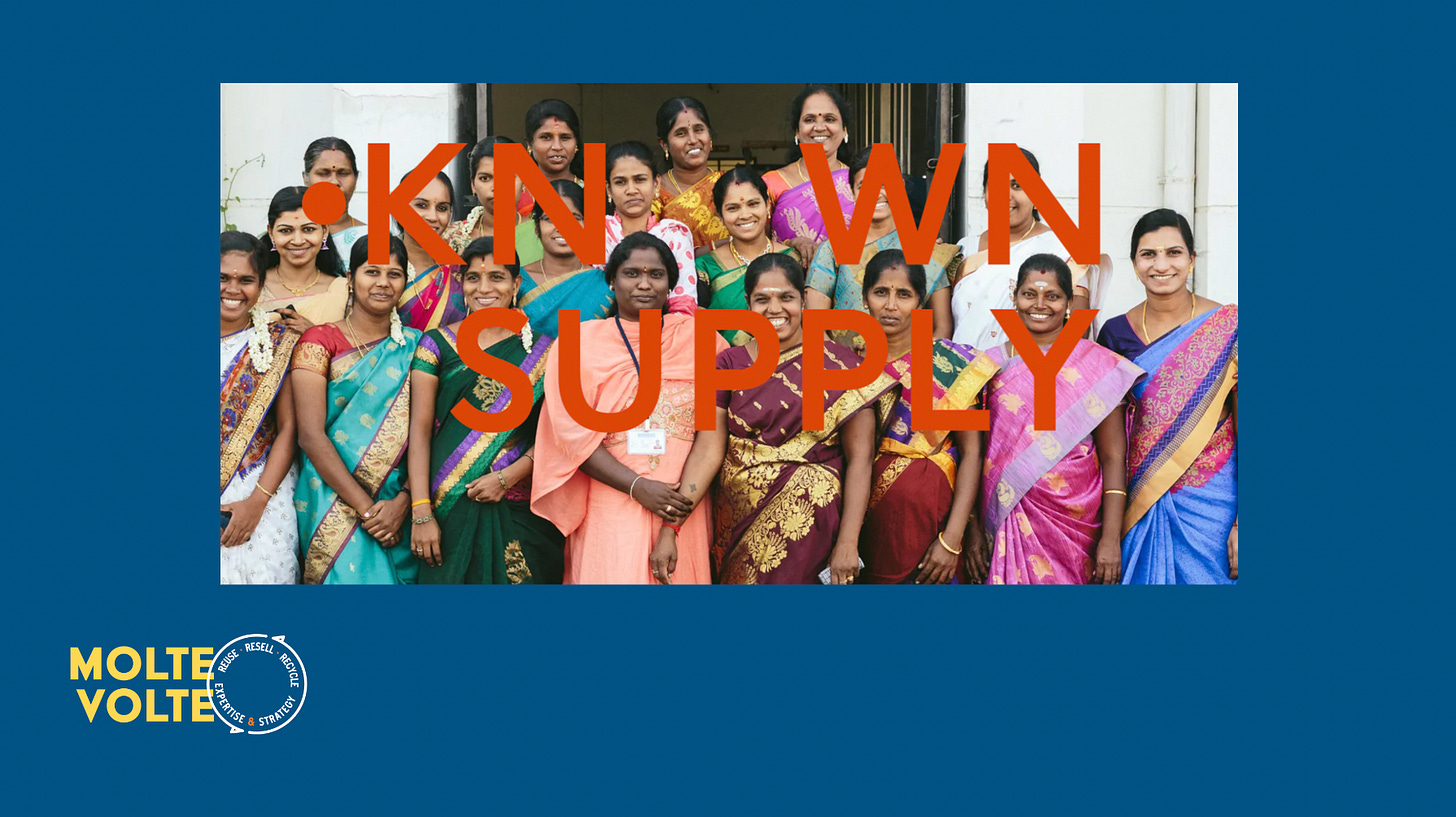Welcome to Molte News #2. This week I’ll share my circular program design for KNOWN SUPPLY.
I hadn’t heard of this brand before, but now that I’ve done a deep dive and spoken with their co-founder, Kohl Crecelius, I am thoroughly impressed. Everything they make is Fair Trade Certified and almost all of their product is 100% organic cotton. SUPER COOL and hard to build that kind of responsible business! These are the types of businesses that will actually make change in our industry. (See Kohl’s Ted Talk here!)
Serendipitously, Kohl was beginning to work on KNOWN SUPPLY’s circular strategy and welcomed my help. I built out a deck for them with detailed program and vendor recommendations, and I’m sharing 3 important slides with you here.
VALUE PROPOSITION
The slide above highlights the big picture reasons KNOWN SUPPLY should have a circular strategy- which are also the benefits of becoming circular. Resale and reuse will be a natural fit for this brand that was founded on responsible production- their customers should get it immediately. Resale and reuse will help KNOWN SUPPLY connect more deeply with their existing customers and bring new customers into their growing brand. And of course, resale and reuse will also benefit our planet and prolong the life of the garments that KNOWN SUPPLY and their supply chain partners worked so hard to create.
PROGRAM DESIGN
The slide above is my at-a-glance circular strategy proposal for KNOWN SUPPLY. First, I think it’s important for Kohl to do some market research and testing with customers before jumping in the deep end. I also like the idea of two types of resale for them: peer-to-peer and take-back. This way they can have the best of both worlds, customers selling to each other and customers selling directly back to the brand. Kohl shared with me that recycling is important to KNOWN SUPPLY, and since they have almost entirely 100% cotton products (which are recyclable), this is absolutely an option for them. I threw in two additional and fun circular-program ideas, upcycling and remanufacturing. If KNOWN SUPPLY wants to visibly repair, overdye or re-make some of their slightly damaged garments, they can create special collections and stories for their customers.
METRICS
Above are key metrics that will help measure and give a robust picture of how circularity initiatives are working for KNOWN SUPPLY.
A few big decision points for KNOWN SUPPLY are:
Take-back: how they want to get products back from their customers. The logistics of take back require some decisions including who will pay for shipping (if customers are sending their products to KNOWN SUPPLY’s warehouse) and if there are any in-person locations where customers can return their products. If KNOWN SUPPLY has a few strong localized markets, they could partner with one of their wholesalers to do take-back.
Sorting: how they want to sort their post-consumer products. This is a crucial step for any type of resale and reuse. All items coming back from customers need to be inspected for condition and cleanliness and then put into their right category, i.e. ‘resale’, ‘repair’, ‘recycling’. Some items will need to be cleaned or repaired which is why many brands outsource the sorting function. I would recommend KNOWN SUPPLY take on sorting themselves in their warehouse, at least to start. Depending on the volume coming in, this could be a significant daily or weekly task.
P2P Software: if KNOWN SUPPLY wants to do P2P resale they will need a software vendor to help add P2P functionality to their website. KNOWN SUPPLY may want to try do their whole circular program in-house, in which case they’d need to stick with take-back only, at least to start. (Jackalo
is a brand I discovered this week who does all their own take-back and resale, which I find quite compelling!)
Recycling: this is important to KNOWN SUPPLY. They will need to work with a vendor or partner who can recycle cotton and can take whatever volume KNOWN SUPPLY is able to get from their customers. They may not get enough from customers right away to meet the minimum volume requirements, so they may need to hold onto recyclable items until a certain volume is reached, at which point the vendor can pick it up. Further, if KNOWN SUPPLY wants to use their own recycled cotton for new collections, they’d probably need an even greater volume of items to warrant their own ‘run’ of the recycling machinery.
I will work with KNOWN SUPPLY on their key questions (mostly around vendors) so they feel set up for success on their circularity strategy.
I hope this glimpse into my work has given you a greater understanding of what I know and do, and please let me know if you or someone you know could use my help.
-Cynthia







